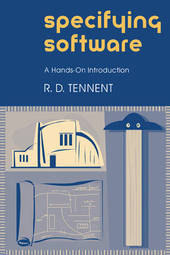
|
Specifying Software: A Hands-On Introduction
Paperback / softback
Main Details
| Title |
Specifying Software: A Hands-On Introduction
|
| Authors and Contributors |
By (author) R. D. Tennent
|
| Physical Properties |
| Format:Paperback / softback | | Pages:302 | | Dimensions(mm): Height 235,Width 156 |
|
| Category/Genre | Software Engineering |
|---|
| ISBN/Barcode |
9780521004015
|
| Classifications | Dewey:005.1 |
|---|
| Audience | | Tertiary Education (US: College) | |
|---|
| Illustrations |
Worked examples or Exercises; 1 Tables, unspecified; 29 Line drawings, unspecified
|
|
Publishing Details |
| Publisher |
Cambridge University Press
|
| Imprint |
Cambridge University Press
|
| Publication Date |
25 February 2002 |
| Publication Country |
United Kingdom
|
Description
Provides an innovative hands-on introduction to techniques for specifying the behaviour of software components. It is primarily intended for use as a text book for a course in the 2nd or 3rd year of Computer Science and Computer Engineering programs, but it is also suitable for self-study. Using this book will help the reader improve programming skills and gain a sound foundation and motivation for subsequent courses in advanced algorithms and data structures, software design, formal methods, compilers, programming languages, and theory. The presentation is based on numerous examples and case studies appropriate to the level of programming expertise of the intended readership. The main topics covered are techniques for using programmer-friendly assertional notations to specify, develop, and verify small but non-trivial algorithms and data representations, and the use of state diagrams, grammars, and regular expressions to specify and develop recognizers for formal languages.
Reviews'The treatment of state diagrams or grammars as specialized specification languages and embedding them into a more general context of specifying algorithms and data representations is an interesting approach that is quite novel ... I would like to single out both the author's approach and his style of presentation as very positive features of the book. Reading this book is definitely inspiring, and not just for a student.' Computing Reviews 'This book was written to support a short course in the second or third year of an undergraduate computer science, software engineering, or software design program. The prerequisites are fairly modest: some programming experience and some exposure to the most basic concepts of discrete mathematics and to the language of elementary logic. Using this book will help readers improve their programming skills and develop a solid foundation for subsequent courses in advanced algorithms and data structures, software design, formal methods, and compilers.' Zentralblatt fur Mathematik
|